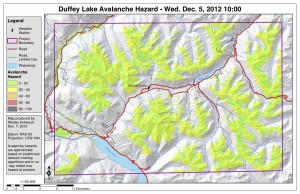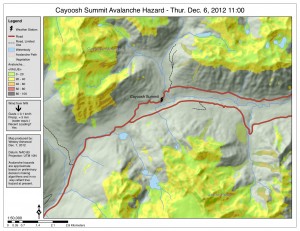As this project is focused on developing a tool that will update avalanche hazard based on fluctuating weather conditions, there is no final result to present. What is presented instead are examples of the types of outputs generated by the tool.
First, is an avalanche hazard overview map of the entire Duffey Lake backcountry area. This was produced using weather data taken on Wednesday December 5th at 10:00. Although the exact score of every area is not known the map gives an understanding that the avalanche hazard is relatively low throughout the area.
The project work boundary was chosen to include most of the common backcountry skiing areas between Lillooet and Duffey Lakes. However, it may not be accurate to consider weather information taken from Cayoosh Pass and apply it 15 to 20 km away. The map below represents a approximation of the areas that may be experiencing weather patterns similar to those recorded at the pass summit.
This map was updated for Thursday December 6th at 11:00. Pockets of considerable avalanche hazard (score between 40 and 60) can now be seen on S and SE facing aspects. At this point in time the weather station was recording winds coming from the NW at a low rate of 0.1 km/h. Regardless of how low the wind is a score is still applied to aspect as shown in the methodology section. Wind combined with the a recent loading of 3mm of precipitation, water equivalent, since 6:00 (a 5 hour time period at the time of map production) gives rise to considerable avalanche potential on lee slopes throughout the area.
The precipitation record will continue for another 7 hours until 18:00 where it will be reset on the URL for the Cayoosh Summit weather station. In this time if precipitation were to continue, or winds increase, the avalanche hazard would increase. If no additional snow or rain is incurred the rate will be lower as time progresses, lowering the avalanche hazard. This is equivalent to snowpack settling and building strength under its own weight. However, the rate at which this occurs is not fully understood and additional consideration is necessary. A further discussion of the limitation of the current model and future work is presented in the future steps section.


